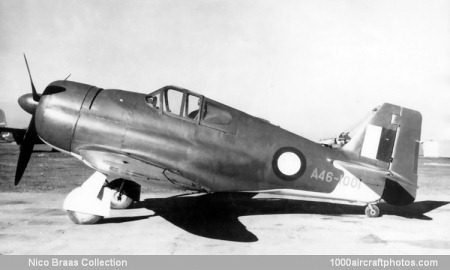There was no prototype and the Boomerang was built in three batches each having minor differences. The initial order was for 105 CA-12 aircraft (c/n 824 to 928, s/n A46-1 to A46-105), and the first example flew on May 29, 1942.
A follow-on contract for 95 CA-13 aircraft (c/n 929 to 1023, s/n A46-106 to A46-200) called for the introduction of minor modifications resulting from initial operational experience. The final production contract covered 49 CA-19 aircraft (c/n 1024 to 1072, s/n A46-201 to A46-249), the last 39 of which were each fitted with a vertical camera for tactical reconnaissance.
Span: 36 ft 0 in (10.97 m)
Length: 25 ft 6 in (7.77 m)
Height: 9 ft 7 in (2.92 m)
Wing area: 225 sq.ft (20.90 sq.m)
Weight empty: 5,373 lb (2,437 kg)
Loaded weight: 7,699 lb (3,492 kg)
Max speed: 305 mph (491 kmh) at 15,500 ft (4,724 m)
Range: 930 mls (1,497 km)
In the mean time, one aircraft was experimentally fitted with a General Electric turbo-supercharger in the rear fuselage, a large air intake was mounted on the port fuselage side behind the cockpit. The wing leading edge center section was modified to reduce drag and the area of the vertical fin was increased. Designated CA-14 (c/n 1074, s/n A46-1001) the aircraft was first flown on January 13, 1943.
Although showing improved performance, the aircraft suffered considerable buffeting. To counter this, the turbo-supercharger air intake was replaced by a streamlined air duct placed between the supercharger and the cleaned-up cowling. Furthermore the vertical surfaces were replaced with the square fin and rudder. In the summer of 1944 the aircraft, redesignated CA-14A, reached a maximum speed of 348 mph (560 kmh) at 27,887 ft (8,500 m).
However, by that time the RAAF was receiving a substantial number of Spitfire F.VIIIs with a maximum speed of (650 kmh) at 7,600 m) and the Boomerang had been relegated to ground-support duty. Consequently, the turbocharged CA-14/CA-14A remained a one-off aircraft.
